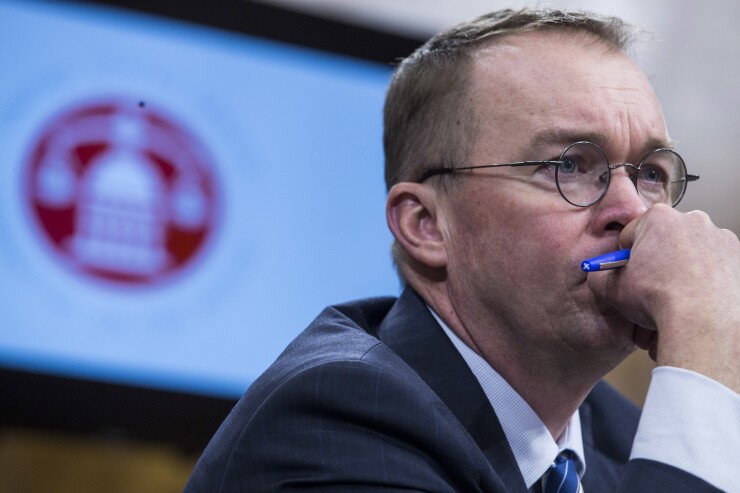Acting Consumer Financial Protection Bureau Director Mick Mulvaney is discarding many of the policy priorities of his predecessor, Richard Cordray, but none as consequential perhaps as the agency's targeting of "unfair, deceptive or abusive acts or practices."
The Dodd-Frank Act prohibited so-called UDAAPs and tasked the CFPB with identifying such acts of wrongdoing and punishing firms that commit them.
Mulvaney cannot repeal that provision, but — as indicated by the agency's new five-year

"It's really a signal that the aggressive enforcement of UDAAP will be coming to an end," said Richard Horn, principal at Richard Horn Legal in Tucson, Ariz., and a former CFPB special counsel and adviser.
The release of the strategic plan was a continuation of Mulvaney's aggressive remaking of the bureau. In addition to an apparent shying away from using UDAAP, the plan also pointed to the CFPB's intention of easing its recent mortgage rules.
The CFPB's previous five-year
But the agency's
The CFPB faced heavy criticism under Cordray for using the UDAAP prohibition as a hammer while not issuing specific rules to guide firms how the agency identified improper practices.
Dodd-Frank contained few if any technical requirements on how the agency can file a claim against a company, Horn said.
The CFPB's reliance on UDAAP in recent years is important because more than 90% of the $12 billion in consumer relief awarded by the CFPB came in cases in which the bureau uncovered evidence of deception, according to
Deception was the most common claim brought by the agency in 73 of 122 cases. Without UDAAP, consumer advocates expect a huge drop in enforcement actions and civil money penalties.
Mulvaney is "minimizing UDAAP because that's where the real action is," said Christopher Peterson, a senior fellow at the Consumer Federation of America, and the John J. Flynn Endowed Professor of Law at the University of Utah, who examined the CFPB's
To be sure, the CFPB has still pledged to use UDAAP, which is listed in the new strategic plan as one of the bureau's objectives, but with an apparently different emphasis. The two bullet points listed under UDAAP describe the agency's intention of ensuring "fair, equitable and non-discriminatory access to credit," and of preventing financial exploitation of the elderly.
Many of the CFPB's
Under Mulvaney, UDAAP cases may still be filed but with far less frequency, observers said.
"The CFPB will still use UDAAP but they won't go out of their way to find UDAAP where it doesn't exist," said Jenny Lee, a partner at Dorsey & Whitney. "Because they are still going to get referrals from consumers and other agencies, and pressure from consumer advocates, in the course of examinations, as they find things, they would still bring a UDAAP claim."
The agency's differing approaches to UDAAP under Cordray and Mulvaney reflect a broader philosophy change.
When the CFPB was first created by the Dodd Frank Act, there was plenty of debate about whether the bureau would be a regulatory agency or an enforcement agency. Cordray's use of UDAAP signaled the latter, but Mulvaney has indicated an interest in outlining clear rules of the road.
"Mulvaney is clearly putting a stake in the ground that [the CFPB] is a regulatory agency," said Ed Mills, a managing director at Raymond James. "If you are not going to use UDAAP for enforcement, it becomes much more of a regulatory agency."
Mills said a reduction in UDAAP claims is consistent with Mulvaney's preference to use cost-benefit analyses to justify agency activities. In the past, the CFPB spent a lot of money and time bringing cases under UDAAP — resources that such a cost-benefit analysis may not support.
"Whenever you're making a change, you need a justification and the justification we're going to see is the cost-benefit analysis," Mills said.
The strategic plan also sent a signal that the CFPB will be using its five-year
This led some analysts to emphasize the plan's effects on the mortgage sector, which is thought to be the area that the agency will focus on most in its first five-year look-back.
"This is the start of a material reconsideration of existing rules," said Jaret Seiberg, a policy analyst at Cowen Washington Research Group. "Servicing is a very complex business where technical violations that do not result in actual consumer harm can be common. We read this strategic plan as the CFPB saying it is not looking to trip up servicers when violations are minor and do not harm consumers."





